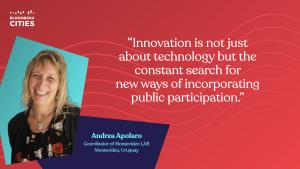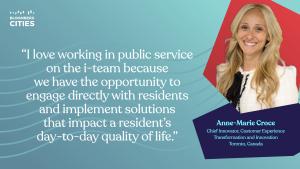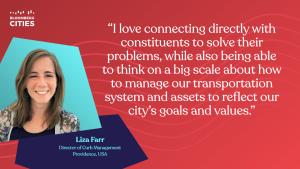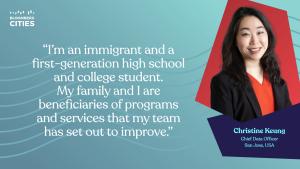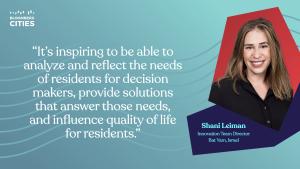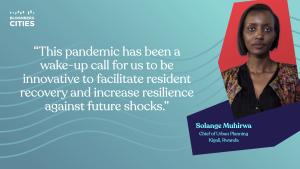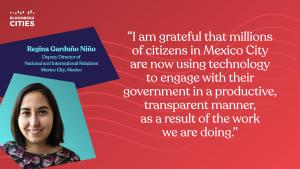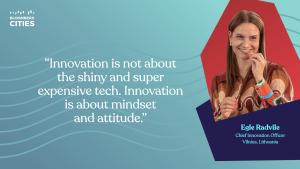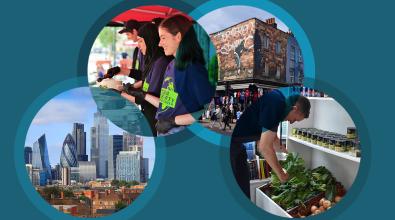How these 13 women are driving city innovations around the world

The past two years have seen unprecedented amounts of local-level innovation, as cities raced to set up testing and vaccine clinics, protect workers and businesses, and keep vulnerable residents fed.
These efforts, which were built on more than a decade of critical investments Bloomberg Philanthropies has made to strengthen and spread public-sector innovation, are now sparking even bolder and more ambitious solutions as cities begin to turn more attention toward recovery. With many of the boldest initiatives, it’s women in local government who are leading the charge.
As we observe Women's History Month, we spoke with women across the Bloomberg Cities network to learn more about their envelope-pushing work, how they’re using key innovation tools—including experimentation, resident engagement, collaboration, data, and bold leadership—to drive these efforts, and what other cities might learn from their work. Here are their stories.
Andrea Apolaro, Montevideo | Elena Bolbolian, Glendale | Susana Carillo, Málaga | Anne-Marie Croce, Toronto | Petra Dzurovčinová, Bratislava | Liza Farr, Providence | Christine Keung, San José | Shani Leiman, Bat Yam | Solange Muhirwa, Kigali | Regina Garduño Niño, Mexico City | Gina Obiri, Minneapolis | Egle Radvile, Vilnius | Grace Simrall, Louisville
Andrea Apolaro
Coordinator of MVDLAB
Montevideo, Uruguay
Residents are the experts of their cities. They know their problems better than anyone else and often have good ideas for how to address those problems. That’s core to how cities apply human-centered design in their work, and it's critical to how Andrea Apolaro thinks of Montevideo’s MVDLAB, a laboratory that brings together residents from different backgrounds to develop projects. When the lab put out a call for solutions for the city’s future, they received 60 proposals from 100 collaborators focused around key themes such as equity, resilience, and migration. From there, 10 proposals were selected for prototyping and testing, and several of them are now on their way to being implemented. For Apolaro, this space represents what’s possible when government becomes more open by fostering collaboration and actively listening to residents. “The greatest achievement for the Montevideo Innovation Lab,” she says, “is taking advantage of the collective intelligence in order to create public value for all.”
Elena Bolbolian
Director of Innovation, Performance and Audit
Glendale, USA
Remote work was once rare in the public sector. Then the pandemic hit, forcing cities overnight to embrace working from home and to maintain and launch new programs that would keep residents safe. Now, as city workers return to the office, Elena Bolbolian is shepherding Glendale’s first hybrid work policy, intended to boost employee morale and ensure city hall remains competitive with other sectors. This “does not come easy to government,” shares Bolbolian — which is why it was so important to ground the policy in data. A survey of eligible employees found 89 percent had interest in a hybrid work schedule. From there, Bolbolian explored remote work policies from eight agencies and took the best practices from each one. A key feature of the policy is eligible employees must work out of the office at least 50 percent of the time. When it comes to developing new policies, she admits not everyone was on board. “Managing a remote workforce requires a different way of working,” says Bolbolian, who recently honed her human-centered design skills in the Bloomberg Philanthropies Innovation Training program. “This shift requires that we accept that employees be measured by their output as opposed to an agreed-upon set of hours or bodies in chairs.”
Susana Carillo
Deputy Mayor for Innovation and Urban Digitalization
Málaga, Spain
Susana Carillo is turning Málaga into a Living Lab where new solutions focused on sustainability can be tested and deployed. The goal? “To create a collaborative innovation ecosystem with companies, universities, and administration, incorporating citizens at the center of it,” she explains. The initiative has already drawn more than €200 million in European funds for innovation projects and has secured companies like Google and Vodafone as partners. The city and its collaborators have already begun targeting projects around smart energy grids and electric mobility. While these projects may seem very centered around new tech, Carillo says that’s not the primary focus of the Living Lab. “We have learned that innovation is not just about implementing technology, but about how to make smart decisions to improve the quality of life for our citizens helping us to achieve a more flexible, more liveable, safer, and more welcoming city.”
Anne-Marie Croce
Chief Innovator, Customer Experience Transformation and Innovation
Toronto, Canada
When Anne-Marie Croce and Toronto’s i-team set out to address affordable housing, which was only exacerbated by the pandemic, speaking to residents with lived experience was a top priority. They tapped into grassroots Facebook groups, conducted nearly 200 surveys, and translated outreach materials in a city where 180 languages are spoken. “We engaged more than 1,500 residents and heard that this was the first time some felt as though their housing challenges were validated,” shares Croce, adding that this was particularly true among lone-parent households and Indigenous peoples. The team produced an Eviction Prevention Handbook, complete with templates of letters residents can send their landlords. In addition to drawing 3,500 visitors a month online, Croce had hard copies printed and distributed in neighborhoods where internet access is limited. “As the digital divide continues to increase, it’s important to design digital and paper-based services to accommodate various socio-economic groups,” she says.
Petra Dzurovčinová
Chief Innovation Officer
Bratislava, Slovakia
Petra Dzurovčinová sees building better digital services as a way local governments can build trust with residents. It’s worked while prototyping, testing, and implementing new digital tools for Bratislava residents while participating in the Bloomberg Philanthropies Digital Innovation Initiative. “Before we launch any service, we vigorously test it with residents and stakeholders,” she says, adding that the process ensures people feel heard and their needs are addressed. Working this way means acting in the open and getting comfortable showing residents, colleagues, and stakeholders plans and unfinished work, Dzurovčinová says. “It requires a different mindset to show something unfinished. It makes you vulnerable, but also can bring great effects.”
Liza Farr
Director of Curb Management
Providence, USA
Curb space in cities has become hotly contested zones for drop offs, pickups, and parking of everything from scooters to electric vehicles. When she started as the first ever curbside administrator for Providence, Liza Farr knew she would need data on all of it to make good decisions. Zeroing in on parking meters to start with, she went out and walked the city’s streets, using a smartphone app to catalog them. The data inventory is already helping the city to manage and fix the meters. She also mapped curb regulations on a key commercial corridor, enabling her to have more informed conversations with business owners and residents. “I won’t pretend that fancy, custom-built technology solutions aren’t helpful,” explains Farr, who participated in a Bloomberg Philanthropies-sponsored training around applying a missions-oriented mindset in local government. "But there’s a lot you can do with pretty simple stuff.”
Christine Keung
Chief Data Officer
San José, USA
In San José, Christine Keung has built a team whose focus is using data to help city leaders retool programs to produce equitable outcomes for residents. In a year, the team has completed six data projects for six different departments. One of those projects led the city to dramatically increase outreach around a city-funded scholarship program to ensure access for low-income families who get the most benefit from it. Keung explains that the team looks to empower frontline city staff with the insights data can open up for them to improve the thousands of small decisions that impact residents’ experiences. “At the end of the day, we’re not doing analysis for analysis’ sake,” Keung says. The goal is “making government decision-making more transparent and accountable to the public.”
Shani Leiman
Innovation Team Director
Bat Yam, Israel
When Shani Leiman and the Bat Yam i-team looked at the problem of improving cleanliness of streets, plazas, and other public spaces, they discovered that part of the issue was private property outside city control. When residents neglect upkeep on their own yards, it encourages people all around to litter. They learned this through in-depth interviews with residents and close observation of how people behave in public. Leiman and her team worked with property owners and municipal stakeholders to design a new model in which the city offers basic cleaning and gardening services to private buildings by charging a small monthly fee. At least three quarters of the residents of any building need to agree to the fee in order to participate. “For the first time, the city took responsibility on private property and offered a sustainable solution,” Leiman says. “Only after analyzing the local laws, having examples from other cities, and providing research results, was I able to convince the partners in the municipality.”
Solange Muhirwa
Chief of Urban Planning
Kigali, Rwanda
Nearly two-thirds of Kigali’s 1.6 million residents live in informal settlements with limited access to water and sanitation services. Solange Muhirwa leads a project that will enable residents to harvest and store rainwater underground, reducing residents’ dependence on commercial water and helping to mitigate flooding. It also will introduce a smart waste disposal system that enables residents to segregate waste in bins that alert collection companies when they’re full. The project, developed in close collaboration with residents in affected neighborhoods, was one of 15 to win a $1 million prize in the Bloomberg Philanthropies Global Mayors Challenge. “This is one of the most exciting projects we have done as a city,” Muhirwa explains. It’s “working directly with the community using the power of nature and technology and letting nature guide us to ideal solutions that address residents’ needs.”
Regina Garduño Niño
Deputy Director of National and International Relations
Mexico City, Mexico
One of Regina Garduño Niño’s key roles is to make sure that solutions developed by Mexico City’s Digital Agency for Public Innovation spread to cities across Mexico and other countries as well. “Mexico City now has policies and tools related to digital transformation that most governments in Latin America do not have yet in place,” she says—and with a new innovation team focused on digital projects, the city is poised to deliver many more solutions to come. But peer-to-peer sharing isn’t a one-way street. Mexico City has lots to learn from other cities as well, and the city saves time and money by learning from others’ experiences. “Latin American cities face common challenges that could be solved if we continue to work together and exchange our expertise,” Garduño Niño says. “Despite our differences, there are many common traits we should continue to explore.”
Gina Obiri
Program Manager, Performance & Innovation
Minneapolis, USA
When Gina Obiri and her colleagues with the Minneapolis i-team asked residents how they felt about shifting certain service calls from police to other responders, they got a staggering 23,551 comments and suggestions. The feedback formed the basis of two new pilot programs. One is focused on how the city responds to mental-health emergencies. Instead of engaging the police, those calls are now routed to two-person behavioral response teams trained in crisis intervention and counseling. The other is aimed at non-emergency calls, such as problems with street parking, which now get routed to 311. Obiri’s work on the pilots was underway before George Floyd was murdered by a Minneapolis police officer, and has become a critical part of the city’s response since. “There was this immeasurable grief, and civil unrest, and all the effects of the pandemic,” Obiri says. “And it just fueled our commitment to making sure that we did read through all 23,551 of those open-ended responses. It was our duty to make sure that we really got all the information that we could from their experiences.”
Egle Radvile
Chief Innovation Officer
Vilnius, Lithuania
From its participation in Bloomberg Philanthropes’ Digital Innovation Initiative to winning the Global Mayors Challenge, Vilnius is showing the world how investing in data and innovation drives results for residents. Chief Innovation Officer Egle Radvile is a critical part of making this work happen and has no plans to slow down any time soon. Using open data, Radvile is implementing an ambitious plan to create and operate three comprehensive maps of Vilnius that cover its underground, city level, and air space. The effort, she says, will allow real estate developers to make informed decisions, accelerate business growth and improve overall quality of life for residents. “You can change now and the future at the same time,” she says.
Grace Simrall
Chief of Civic Innovation and Technology
Louisville, USA
As everything from the pandemic to automation sends shockwaves through the workforce, Grace Simrall is working to ensure that Louisville is ready to adapt. That’s why she helped create the Future of Work Initiative. It’s a public-private partnership with Microsoft and the Brookings Institution focused on transforming the city into a regional hub and center for excellence in artificial intelligence, internet-connected devices, and data science. In response to the pandemic, residents were offered free online tools to build valuable skills in data analytics, digital marketing, software engineering, and user experience design. That program saw particularly high interest among women and Black residents, who are underrepresented in regional tech jobs, and 200 people went on to earn professional credentials. In this kind of work, partnerships are essential, Simrall says. “To be successful in implementing transformational innovations, cities need to work on building broad coalitions of stakeholders aligned around a shared vision that clearly defines the interest, risk tolerance, and reciprocity of the coalition.”
